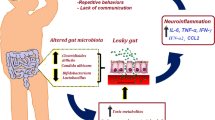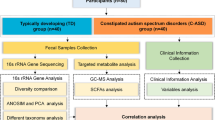Abstract
The aim of this study is to assess the prevalence of small intestinal bacterial overgrowth (SIBO) by hydrogen breath test in patients with autism spectrum disorders (ASD) with respect to a consistent control group. From 2011 to 2013, 310 children with ASD and 1240 sex- and age-matched typical children were enrolled in this study to undergo glucose breath test. The study participants were considered to exhibit SIBO when an increase in H2 of ≥20 ppm or CH4 of ≥10 ppm with respect to the fasting value was observed up to 60 min after the ingestion of glucose. Ninety-six children with autism suffered from SIBO, giving a prevalence rate of SIBO was 31.0% (95% CI 25.8–36.1%). In contrast, 9.3% of the typical children acknowledged SIBO. The difference between groups was statistically significant (P < 0.0001). The median Autism Treatment Evaluation Checklist (ATEC) score in the children with autism and with SIBO was significantly high when compared with the children without autism and without SIBO [98 (IQR, 45–120) vs. 63 (32–94), P < 0.001]. For the autism group, the 6-GI Severity Index (6-GSI) score was found to be strongly and significantly correlated with the total ATEC score (r = 0.639, P < 0.0001). SIBO was significantly associated with worse symptoms of autism, demonstrating that children with SIBO may significantly contribute to symptoms of autism.


Similar content being viewed by others
Abbreviations
- ASD:
-
Autism spectrum disorder
- GI:
-
Gastrointestinal
- IBD:
-
Inflammatory bowel disease
- VTE:
-
Venous thromboembolism
- NBS:
-
Expanded newborn screening
- ADI-R:
-
Autism Diagnostic Interview-Revised
- SIBO:
-
Small intestine bacterial overgrowth (SIBO)
- ATEC:
-
Autism Treatment Evaluation Checklist
- BMI:
-
Body mass index
- NICU:
-
Neonatal intensive care unit
- 6-GSI:
-
6-Gastrointestinal Severity Index
- ID:
-
Intellectual disability
- IQ:
-
Intelligence quotient
- H2 :
-
Hydrogen
- CH4 :
-
Methane
- SD:
-
Standard deviation
- IQR:
-
Interquartile ranges
- LPS:
-
Lipopolysaccharide
References
Rai D, Lee BK, Dalman C, Golding J, Lewis G, Magnusson C (2013) Parental depression, maternal antidepressant use during pregnancy, and risk of autism spectrum disorders: population based case-control study. BMJ 346:f2059
Tu W, Yin C, Guo Y, Li SO, Chen H, Zhang Y, Feng YL, Long BH (2013) Serum homocysteine concentrations in Chinese children with autism. Clin Chem Lab Med 51(2):e19–e22
Kang DW, Park JG, Ilhan ZE, Wallstrom G, Labaer J, Adams JB, Krajmalnik-Brown R (2013) Reduced incidence of Prevotella and other fermenters in intestinal microflora of autistic children. PLoS One 8(7):e68322
Tomova A, Husarova V, Lakatosova S, Bakos J, Vlkova B, Babinska K, Ostatnikova D (2015) Gastrointestinal microbiota in children with autism in Slovakia. Physiol Behav 138:179–187
de Theije CGM, Wopereis H, Ramadan M, van Eijndthoven T, Lambert J, Knol J, Garssen J, Kraneveld AD, Oozeer R (2014) Altered gut microbiota and activity in a murine model of autism spectrum disorders. Brain Behav Immun 37:197–206
Gondalia SV, Palombo EA, Knowles SR, Cox SB, Meyer D, Austin DW (2012) Molecular characterisation of gastrointestinal microbiota of children with autism (with and without gastrointestinal dysfunction) and their neurotypical siblings. Autism Res 5(6):419–427
Donowitz JR, Petri WA (2015) Pediatric small intestine bacterial overgrowth in low-income countries. Trends Mol Med 21(1):6–15
Lupascu A, Gabrielli M, Lauritano EC, Scarpellini E, Santoliquido A, Cammarota G, Flore R, Tondi P, Pola P, Gasbarrini G, Gasbarrini A (2005) Hydrogen glucose breath test to detect small intestinal bacterial overgrowth: a prevalence case–control study in irritable bowel syndrome. Aliment Pharmacol Ther 22(11–12):1157–1160
Tan AH, Mahadeva S, Thalha AM, Gibson PR, Kiew CK, Yeat CM, Ng SW, Ang SP, Chow SK, Tan CT, Yong HS, Marras C, Fox SH, Lim SY (2014) Small intestinal bacterial overgrowth in Parkinson’s disease. Parkinsonism Relat Disord 20(5):535–540
Sartor RB (2008) Microbial influences in inflammatory bowel diseases. Gastroenterology 134(2):577–594
Fialho A, Fialho A, Schenone A, Thota P, McCullough A, Shen B (2016) Association between small intestinal bacterial overgrowth and deep vein thrombosis. Gastroenterol Rep 4(4):299–303
Geier DA, Kern JK, Geier MR (2013) A comparison of the Autism Treatment Evaluation Checklist (ATEC) and the Childhood Autism Rating Scale (CARS) for the quantitative evaluation of autism. J Mental Health Res Intell Disabil 6(4):255–267
Cryan JF, Dinan TG (2012) Mind-altering microorganisms: the impact of the gut microbiota on brain and behaviour. Nat Rev Neurosci 13(10):701–712
Leiby A, Mehta D, Gopalareddy V, Jackson-Walker S, Horvath K (2010) Bacterial overgrowth and methane production in children with encopresis. J Pediatr 156:766–770
Parracho HMRT, Bingham MO, Gibson GR, McCartney AL (2005) Differences between the gut microflora of children with autistic spectrum disorders and that of healthy children. J Med Microbiol 54(10):987–991
de Magistris L, Familiari V, Pascotto A, Sapone A, Frolli A, Iardino P, Carteni M, De Rosa M, Francavilla R, Riegler G, Militerni R, Bravaccio C (2010) Alterations of the intestinal barrier in patients with autism spectrum disorders and in their first-degree relatives. J Pediatr Gastroenterol Nutr 51(4):418–424
Finegold SM, Dowd SE, Gontcharova V, Liu C, Henley KE, Wolcott RD, Youn E, Summanen PH, Granpeesheh D, Dixon D, Liu M, Molitoris DR, Green JA (2010) Pyrosequencing study of fecal microflora of autistic and control children. Anaerobe 16(4):444–453
Finegold SM, Summanen PH, Downes J (2017) Detection of Clostridium perfringens toxin genes in the gut microbiota of autistic children. Anaerobe 45:133–137
Adams JB, Johansen LJ, Powell LD, Quig D, Rubin RA (2011) Gastrointestinal flora and gastrointestinal status in children with autism—comparisons to typical children and correlation with autism severity. BMC gastroenterology 11(1):1
Mello CS, Tahan S, Melli LC, Rodrigues MS, de Mello RM, Scaletsky IC, de Morais MB (2012) Methane production and small intestinal bacterial overgrowth in children living in a slum. World J Gastroenterol 18:5932–5939
dos Reis JC, de Morais MB, Oliva CA, Fagundes-Neto U (2007) Breath hydrogen test in the diagnosis of environmental enteropathy in children living in an urban slum. Dig Dis Sci 52:1253–1258
Pereira SP, Khin-Maung-U TD, Duncombe VM, Nyunt- Nyunt-Wai JM (1991) A pattern of breath hydrogen excretion suggesting small bowel bacterial overgrowth in Burmese village children. J Pediatr Gastroenterol Nutr 13:32–38
Molloy CA, Manning-Courtney P (2003) Prevalence of chronic gastrointestinal symptoms in children with autism and autistic spectrum disorders. Autism 7(2):165–171
Nikolov RN, Bearss KE, Lettinga J, Erickson C, Rodowski M, Aman MG, McCracken JT, McDougle CJ, Tierney E, Vitiello B, Arnold EL, Shah B, Posey DJ, Ritz L, Scahill L (2009) Gastrointestinal symptoms in a sample of children with pervasive developmental disorders. J Autism Dev Disord 39:405–413
Ming X, Brimacombe M, Chaaban J, Zimmerman-Bier B, Wagner GC (2008) Autism spectrum disorders: concurrent clinical disorders. J Child Neurol 23(1):6–13
Adams JB, Holloway CE, George F, Quig D (2006) Analyses of toxic metals and essential minerals in the hair of arizona children with autism and their mothers. Biol Tr El Res 110:193–209
Luna RA, Oezguen N, Balderas M, Venkatachalam A, Runge JK, Versalovic J, Veenstra-VanderWeele J, Anderson GM, Savidge T, Williams KC (2017) Distinct microbiome-neuroimmune signatures correlate with functional abdominal pain in children with autism spectrum disorder. Cell Mol Gastroenterol Hepatol 3(2):218–230
Sandler RH, Finegold SM, Bolte ER, Buchanan CP, Maxwell AP, Väisänen ML, Nelson MN, Wexler HM (2000) Short-term benefit from oral vancomycin treatment of regressive-onset autism. J Child Neurol 15(7):429–435
MacFabe DF, Cain DP, Rodriguez-Capote K, Franklin AE, Hoffman JE, Boon F, Taylor AR, Kavaliers M, Ossenkopp KP (2007) Neurobiological effects of intraventricular propionic acid in rats: possible role of short chain fatty acids on the pathogenesis and characteristics of autism spectrum disorders. Behav Brain Res 176(1):149–169
Louis P (2012) Does the human gut microbiota contribute to the etiology of autism spectrum disorders? Dig Dis Sci 57(8):1987–1989
Critchfield JW, Van Hemert S, Ash M, Mulder L, Ashwood P (2011) The potential role of probiotics in the management of childhood autism spectrum disorders. Gastroenterol Res Pract 2011(2011):161358-1–161358-8. doi:10.1155/2011/161358
Zhang Y, Hodgson NW, Trivedi MS, Abdolmaleky HM, Fournier M, Cuenod M, Do KQ, Deth RC (2016) Decreased brain levels of vitamin B12 in aging, autism and schizophrenia. PLoS One 11(1):e0146797
Khalighi AR, Khalighi MR, Behdani R, Jamali J, Khosravi A, Kouhestani Sh, Radmanesh H, Esmaeelzadeh S, Khalighi N (2014) Evaluating the efficacy of probiotic on treatment in patients with small intestinal bacterial overgrowth (SIBO)—a pilot study. Indian J Med Res 140(5):604–608
Adams JB, Romdalvik J, Levine KE, Hu LW (2008) Mercury in first-cut baby hair of children with autism versus typically-developing children. Toxicol Environ Chem 90:739–753
Zhu YG, Carvey PM, Ling ZD (2007) Altered glutathione homeostasis in animals prenatally exposed to lipopolysaccharide. Neurochem Int 50:671–680
Kang DW, Adams JB, Gregory AC, Borody T, Chittick L, Fasano A, Khoruts A, Geis E, Maldonado J, McDonough-Means S, Pollard EL, Roux S, Sadowsky MJ, Lipson KS, Sullivan MB, Caporaso JG, Krajmalnik-Brown R (2017) Microbiota transfer therapy alters gut ecosystem and improves gastrointestinal and autism symptoms: an open-label study. Microbiome 5(1):10
Navarro F, Liu Y, Rhoads JM (2016) Can probiotics benefit children with autism spectrum disorders? World J Gastroenterol 22(46):10093–10102
Niu XL, Liu L, Song ZX, Li Q, Wang ZH, Zhang JL, Li HH (2016) Prevalence of small intestinal bacterial overgrowth in Chinese patients with Parkinson’s disease. J Neural Transm 123(12):1381–1386
Acknowledgements
This work was supported by the National Natural Science Foundation of China (30950031). The funding organizations had no role in the design and concept of the study; the collection, management, analysis, and interpretation of the data; or the preparation, review, or approval of the manuscript.
Author information
Authors and Affiliations
Corresponding author
Ethics declarations
Conflict of interest
All authors have no conflicts of interest to disclose.
Rights and permissions
About this article
Cite this article
Wang, L., Yu, YM., Zhang, Yq. et al. Hydrogen breath test to detect small intestinal bacterial overgrowth: a prevalence case–control study in autism. Eur Child Adolesc Psychiatry 27, 233–240 (2018). https://doi.org/10.1007/s00787-017-1039-2
Received:
Accepted:
Published:
Issue Date:
DOI: https://doi.org/10.1007/s00787-017-1039-2




